This article was medically reviewed by Catherine Cheung, DPM. Dr. Catherine Cheung is a board certified Podiatrist based in San Francisco, California. Dr. Cheung specializes in all aspects of foot and ankle care, including complex reconstruction. Dr. Cheung is affiliated with the Brown & Toland Physicians and the Sutter Medical Network. She earned a DPM from the California College of Podiatric Medicine, completed her residency at the Encino Tarzana Medical Center, and completed a fellowship at the Kaiser Permanente San Francisco Medical Center. She is board certified by the American Board of Podiatric Surgery.
There are 19 references cited in this article, which can be found at the bottom of the page.
wikiHow marks an article as reader-approved once it receives enough positive feedback. In this case, 97% of readers who voted found the article helpful, earning it our reader-approved status.
This article has been viewed 204,036 times.
Taking a load off and elevating your feet feels great, particularly if they’re swollen. Whether your feet are puffy due to pregnancy or too much walking, elevating them can make you more comfortable. By raising and resting your feet, reducing foot swelling, and maintaining good foot health, you can keep your feet ready for all your favorite activities.[1]
Steps
Raising and Resting Your Feet
-
1Remove your shoes. Take off your shoes and socks before elevating your feet. Shoes can cause blood to pool in your feet and encourage swelling. Socks can do this too, particularly if they are tight around the ankle. Give your toes a quick wiggle to get your blood flowing.[2]
-
2Lie down on a comfortable couch or in bed. Stretch your body out on a long couch or bed, lying on your back. Make sure you have lots of room and that you don’t feel you’re going to roll off the couch. Prop up your back and neck with a pillow or two if it makes you feel more comfortable.[3]
- Avoid lying flat on your back if you are pregnant and past the first trimester. Your uterus can put too much pressure on a central artery, actually suppressing blood flow, which is the opposite of what you want to do. Place a couple of pillows behind your back so you are propped up at a 45-degree angle.[4]
Advertisement -
3Use pillows to raise your feet up to the level of your heart. Place pillows underneath your feet and ankles to elevate them. Stack as many as necessary to elevate your feet to the level of your heart. Raising your feet to heart level will help drain pooled blood from your feet and make it easier for your heart to increase circulation.[5]
- You may be most comfortable putting a pillow or two underneath your calves as well to support your elevated feet.
-
4Keep your feet elevated for 20-minute intervals throughout the day. Regular 20 minute intervals of elevation should reduce the swelling.[6] You can use this opportunity to catch up on email, watch a movie, or accomplish other tasks that don’t require you to stand.
- If you have an injury, such as a sprained ankle, you’ll want to elevate your foot more often. Try to have your foot elevated for a total of 2-3 hours each day.[7]
- If you find that your foot swelling doesn’t go down by using this routine for a few days, you should make an appointment with your doctor.[8]
-
5Place your feet on a footstool when sitting in a chair. Even slight elevation will reduce everyday swelling. Use an ottoman or footstool to lift your feet off the ground whenever possible while seated. Raising your feet will increase blood circulation.[9]
- You can purchase a small footstool for under your desk if you spend lots of time sitting at work.
-
6Apply ice if it feels good. Use an ice pack wrapped in a tea towel to ice your elevated feet for up 20 minutes a time. Wait at least 20 minutes between ice applications.[10] Doing this can reduce swelling further and ease any discomfort you’re experiencing. Always use a barrier between the ice and your bare skin.[11]
- If you’re feeling the need to ice your feet more frequently due to swelling and pain, make an appointment with your doctor.
Reducing Foot Swelling
-
1Avoid sitting for long periods of time. Get up once an hour and walk around for a minute or two just to keep your blood flowing. Long periods of sitting can cause blood to pool in your feet, which causes more swelling. If you have to sit for a long period of time, use a footstool to help promote circulation.[12]
-
2Wear support stockings. Wear full-length support stockings to increase blood flow and ease swelling in your feet. Stockings are most effective if you wear them all day, particularly if you’re going to be standing a lot. Avoid compression socks, which may squeeze above the ankle and encourage foot swelling.[13]
- You can purchase support stockings online at health supply stores, such as ExMed and Walgreens.
-
3Drink 6 to 8 8-ounce glasses of water a day. Drinking enough water can flush your body of extra salt and reduce foot swelling. Some adults may need more or less depending upon pregnancy or other health conditions. For most people though, drinking at least 48 ounces (1.4 liters) of water a day will keep excess swelling to a minimum.[14]
- While the occasional soda or coffee is fine, do not count these beverages as part of your daily water intake. They can have a diuretic effect.[15]
- Don't force yourself to drink more if you can't.
-
4Get regular exercise. Aim to work out for at least 30 minutes 4 to 5 days a week to keep your blood flowing. Even a casual walk will keep your heart rate up and discourage blood from pooling in your feet. If you’re sedentary right now, slowly work your way up to 4 days a week by starting with a 15 minute session one day at a time.[16]
- If you have limitations due to pregnancy or injury, ask your doctor what exercises you can do to alleviate swelling.
- Exercising with a buddy can be a great way to stick to a new fitness routine.
- Certain yoga poses, such as lying on the floor with your legs up against the wall, can reduce foot swelling, too.[17]
-
5Avoid wearing shoes that are too small. Wear shoes that fit you well and ensure that the ball of your foot fits in the widest part of the shoe easily. When you wear shoes that are too small, it can cut off circulation, causing pain or even injury.[18]
Maintaining Good Foot Health
-
1Wear supportive shoes for exercise. Thick-soled sneakers can provide your feet with additional cushion for running and jumping when you exercise. You can also buy gel inserts for added support. Always wear shoes with lots structure and stability if you’re going to be active.
- Shop for shoes at the end of the day when your feet are at their most swollen. Shoes should fit your feet well, even when they’re at their largest.
-
2Lose any extra weight. Try to maintain a healthy weight for your height through diet and exercise. Additional pounds can put pressure on your feet and strain your blood vessels, particularly if you’re active. Even losing a pound or two will decrease everyday foot swelling.[19]
- Your doctor can advise you on a healthy weight range for you.
-
3Avoid wearing high heels every day. Opt for high heels shorter than two inches and try not to wear them often. High heels can pinch your feet, and they put lots of pressure on the ball of your foot. Putting so much weight on a small area like this can cause swelling, pain and even displace bones.[20]
- If you want to wear high heels, a chunky heel rather than a stiletto will provide more stability.
-
4Don’t smoke. Smoking taxes your heart and makes circulating your blood more difficult. Particularly since your feet are so far from your heart, they can get swollen and shiny as a result. Your skin can even start to thin. Consider a regimen to quit smoking to improve your overall health as well as the health of your feet.[21]
-
5Massage your feet to ease pain and improve circulation when needed. Rub the sole of your foot with a rolling pin to get your blood moving. You can even ask a partner to rub the soles of your feet, which will increase circulation and clear pooled blood. Use your fingers to massage any areas of tightness or discomfort.[22]
-
6Take over-the-counter anti-inflammatories to manage minor pain. If your doctor has ruled out more serious conditions, it is usually safe to take over-the-counter anti-inflammatories to manage foot swelling. Take 200 to 400 milligrams of ibuprofen every 4 to 6 hours as needed to diminish puffiness and reduce discomfort.[23]
- Always check with your doctor before taking any medication. Some medications and medical conditions may interact with non-steroidal anti-inflammatories (NSAIDs), such as ibuprofen.
Expert Q&A
Did you know you can get expert answers for this article?
Unlock expert answers by supporting wikiHow
-
QuestionWhat can I do if I can't elevate my foot?
 Catherine Cheung, DPMDr. Catherine Cheung is a board certified Podiatrist based in San Francisco, California. Dr. Cheung specializes in all aspects of foot and ankle care, including complex reconstruction. Dr. Cheung is affiliated with the Brown & Toland Physicians and the Sutter Medical Network. She earned a DPM from the California College of Podiatric Medicine, completed her residency at the Encino Tarzana Medical Center, and completed a fellowship at the Kaiser Permanente San Francisco Medical Center. She is board certified by the American Board of Podiatric Surgery.
Catherine Cheung, DPMDr. Catherine Cheung is a board certified Podiatrist based in San Francisco, California. Dr. Cheung specializes in all aspects of foot and ankle care, including complex reconstruction. Dr. Cheung is affiliated with the Brown & Toland Physicians and the Sutter Medical Network. She earned a DPM from the California College of Podiatric Medicine, completed her residency at the Encino Tarzana Medical Center, and completed a fellowship at the Kaiser Permanente San Francisco Medical Center. She is board certified by the American Board of Podiatric Surgery.
Board Certified Podiatrist
-
QuestionShould I see a doctor about swollen feet?
 Catherine Cheung, DPMDr. Catherine Cheung is a board certified Podiatrist based in San Francisco, California. Dr. Cheung specializes in all aspects of foot and ankle care, including complex reconstruction. Dr. Cheung is affiliated with the Brown & Toland Physicians and the Sutter Medical Network. She earned a DPM from the California College of Podiatric Medicine, completed her residency at the Encino Tarzana Medical Center, and completed a fellowship at the Kaiser Permanente San Francisco Medical Center. She is board certified by the American Board of Podiatric Surgery.
Catherine Cheung, DPMDr. Catherine Cheung is a board certified Podiatrist based in San Francisco, California. Dr. Cheung specializes in all aspects of foot and ankle care, including complex reconstruction. Dr. Cheung is affiliated with the Brown & Toland Physicians and the Sutter Medical Network. She earned a DPM from the California College of Podiatric Medicine, completed her residency at the Encino Tarzana Medical Center, and completed a fellowship at the Kaiser Permanente San Francisco Medical Center. She is board certified by the American Board of Podiatric Surgery.
Board Certified Podiatrist
-
QuestionIs heat or ice better for swollen feet?
 Catherine Cheung, DPMDr. Catherine Cheung is a board certified Podiatrist based in San Francisco, California. Dr. Cheung specializes in all aspects of foot and ankle care, including complex reconstruction. Dr. Cheung is affiliated with the Brown & Toland Physicians and the Sutter Medical Network. She earned a DPM from the California College of Podiatric Medicine, completed her residency at the Encino Tarzana Medical Center, and completed a fellowship at the Kaiser Permanente San Francisco Medical Center. She is board certified by the American Board of Podiatric Surgery.
Catherine Cheung, DPMDr. Catherine Cheung is a board certified Podiatrist based in San Francisco, California. Dr. Cheung specializes in all aspects of foot and ankle care, including complex reconstruction. Dr. Cheung is affiliated with the Brown & Toland Physicians and the Sutter Medical Network. She earned a DPM from the California College of Podiatric Medicine, completed her residency at the Encino Tarzana Medical Center, and completed a fellowship at the Kaiser Permanente San Francisco Medical Center. She is board certified by the American Board of Podiatric Surgery.
Board Certified Podiatrist
Warnings
- If your foot swelling doesn’t reduce after regular elevation for a couple of days, visit your doctor for a check up.[24]⧼thumbs_response⧽
- Certain serious conditions, such as kidney and heart disease can cause foot swelling, so don’t ignore persistent swelling.⧼thumbs_response⧽
- Call a doctor immediately if you experience pain, redness or warmth in a swollen area or if you have an open sore in the area.⧼thumbs_response⧽
- Call a doctor if you are experiencing shortness of breath or swelling in just one limb.⧼thumbs_response⧽
- Protect swollen areas from additional pressure or injury, since these areas don’t heal as well.⧼thumbs_response⧽
References
- ↑ Catherine Cheung, DPM. Board Certified Podiatrist. Expert Interview. 21 April 2019.
- ↑ https://patient.info/health/peripheral-arterial-disease-leaflet
- ↑ https://my.clevelandclinic.org/health/articles/edema
- ↑ https://www.whattoexpect.com/pregnancy/sleep-solutions/pregnancy-sleep-positions/
- ↑ http://www.aafp.org/afp/2002/1015/p1517.html
- ↑ http://www.foot-pain-explored.com/swollen-foot.html
- ↑ http://www.aafp.org/afp/2002/1015/p1517.html
- ↑ Catherine Cheung, DPM. Board Certified Podiatrist. Expert Interview. 21 April 2019.
- ↑ https://health.clevelandclinic.org/2016/06/6-best-ways-relieve-swollen-feet-ankles-home/
- ↑ https://health.clevelandclinic.org/2014/08/should-you-use-ice-or-heat-for-pain-infographic/
- ↑ Catherine Cheung, DPM. Board Certified Podiatrist. Expert Interview. 21 April 2019.
- ↑ http://www.npr.org/sections/health-shots/2015/05/01/403523463/two-minutes-of-walking-an-hour-boosts-health-but-its-no-panacea
- ↑ http://www.mayoclinic.org/diseases-conditions/edema/basics/lifestyle-home-remedies/con-20033037
- ↑ http://www.mayoclinic.org/healthy-lifestyle/nutrition-and-healthy-eating/in-depth/water/art-20044256
- ↑ http://www.mayoclinic.org/healthy-lifestyle/nutrition-and-healthy-eating/expert-answers/caffeinated-drinks/faq-20057965
- ↑ http://www.self.com/story/heres-what-a-perfect-week-of-working-out-looks-like
- ↑ https://health.clevelandclinic.org/2016/06/6-best-ways-relieve-swollen-feet-ankles-home/
- ↑ https://www.hopkinsscleroderma.org/scleroderma/frequently-asked-questions/
- ↑ https://health.clevelandclinic.org/2016/06/6-best-ways-relieve-swollen-feet-ankles-home/
- ↑ http://www.mayoclinic.org/diseases-conditions/diabetes/in-depth/amputation-and-diabetes/art-20048262
- ↑ http://www.everydayhealth.com/foot-health/foot-health-and-smoking.aspx
- ↑ http://www.mayoclinic.org/healthy-lifestyle/pregnancy-week-by-week/expert-answers/swelling-during-pregnancy/faq-20058467
- ↑ https://www.drugs.com/dosage/ibuprofen.html#Usual_Adult_Dose_for_Pain
- ↑ Catherine Cheung, DPM. Board Certified Podiatrist. Expert Interview. 21 April 2019.
About This Article
To elevate your feet, remove your shoes and socks first, since keeping them on can cause your feet to swell when they’re raised. Then, lie down on a bed or couch with your head propped up on some pillows. Use a pillow or 2 to raise your feet to the level of your heart. Alternatively, sit in a chair and put your feet on a foot stool. Plan to keep your feet elevated for 20 minutes at a time during the day, which will help reduce swelling. If your feet still feel sore, apply an ice pack wrapped in a towel to them for 10 minutes at a time. If your swelling doesn’t drop after several days of raising your feet, make an appointment to see your doctor. For tips from our Medical co-author on how to prevent swelling by wearing the right kind of shoes, keep reading!

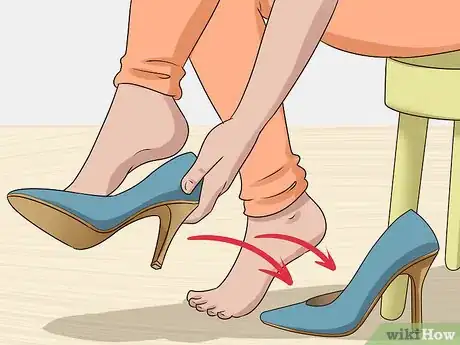
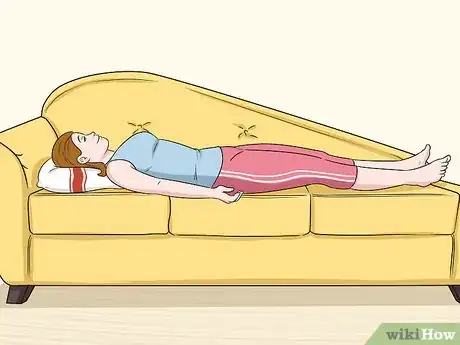
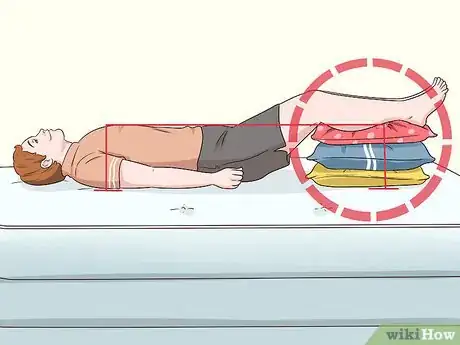
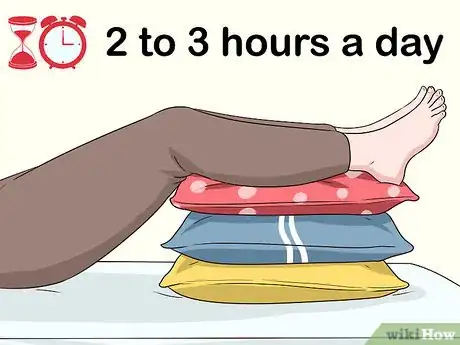

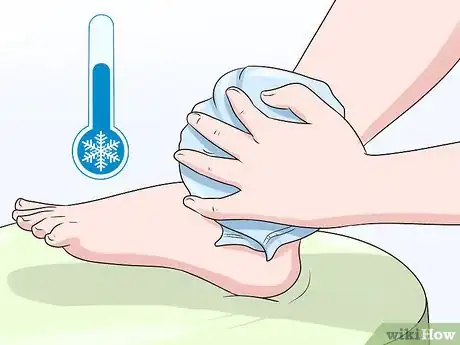

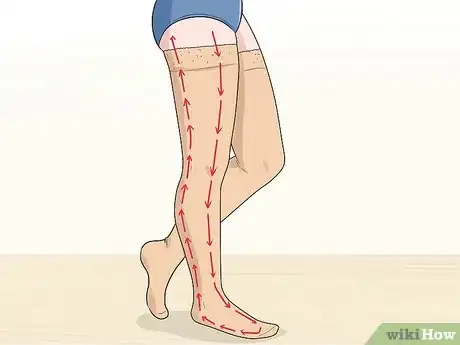

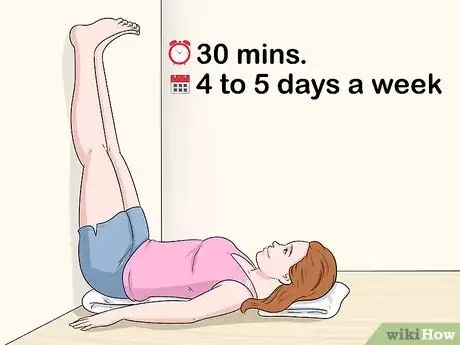

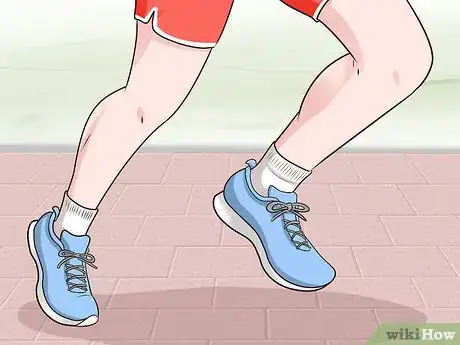
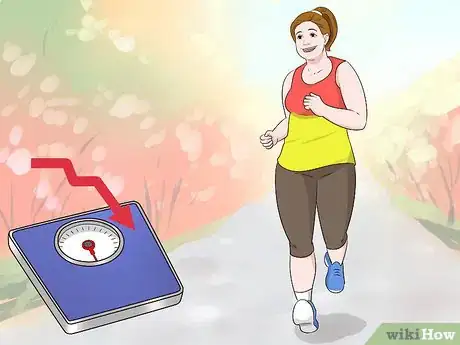
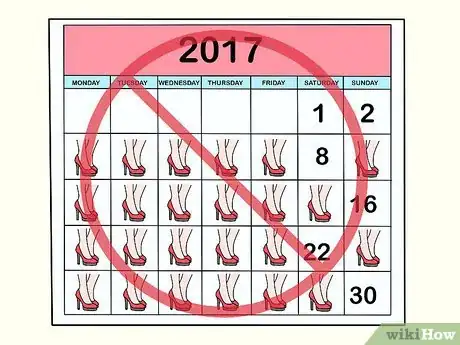


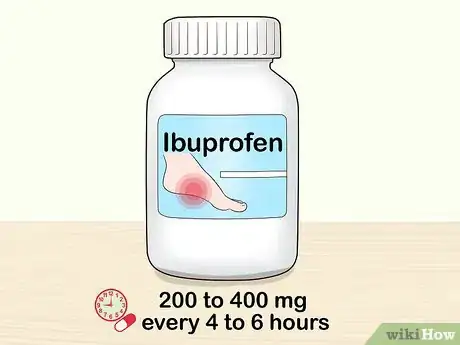


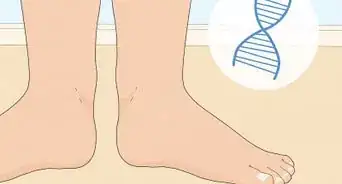




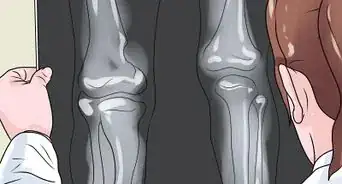
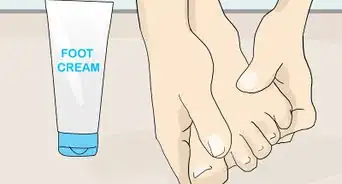
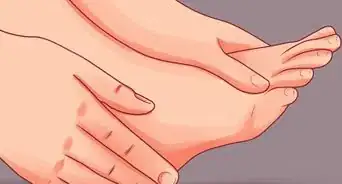













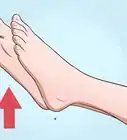





































Medical Disclaimer
The content of this article is not intended to be a substitute for professional medical advice, examination, diagnosis, or treatment. You should always contact your doctor or other qualified healthcare professional before starting, changing, or stopping any kind of health treatment.
Read More...